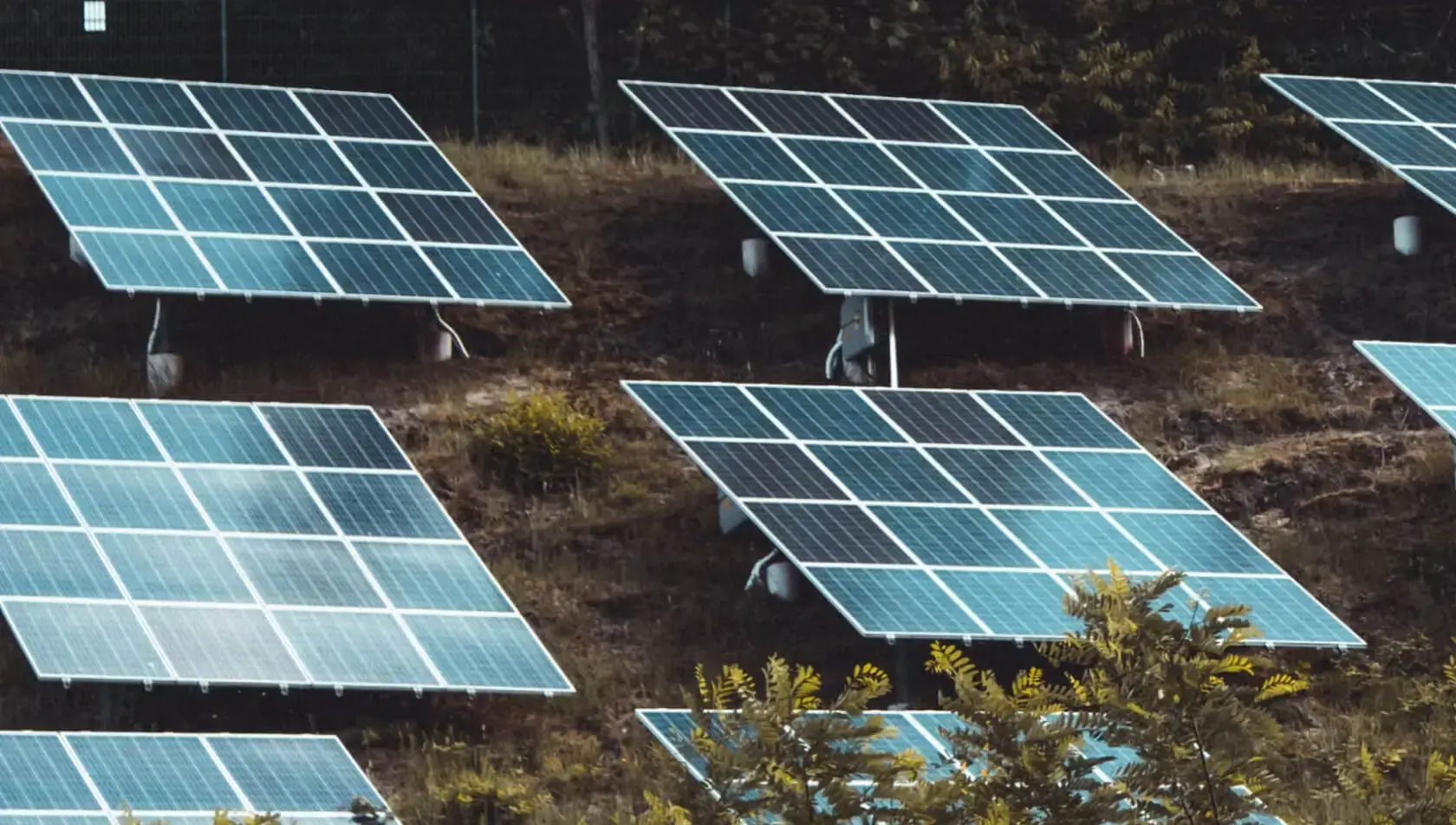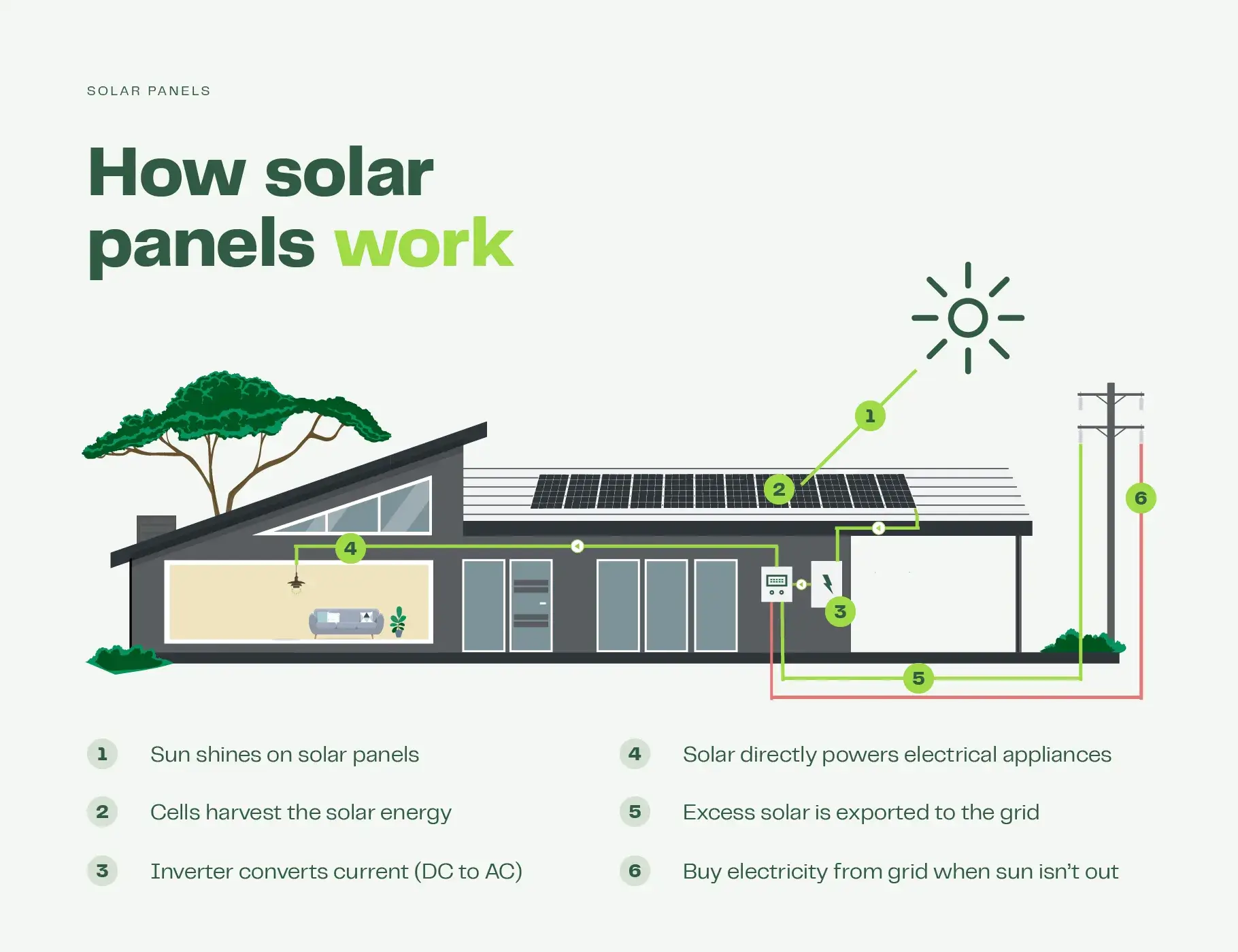How solar panels
work

Solar panels work by converting sunlight into electricity that you can use to power appliances in your home. The sun’s light, and not heat, generates direct current (DC), an inverter then converts the direct current into alternate current (AC) that you can use in your home to power your electrical appliances.
Solar panel diagram explaining how solar power works
Solar panels work during daylight hours
Solar panels generate electricity during daylight hours. If you are not at home to use the electricity, it gets sent back to the grid where you receive a feed-in tariff for every kilowatt hour (kWh) you export.
At night, or when it is overcast, you buy your electricity from the grid to power appliances in your home.
How solar panels work step-by-step
How the sun can power electrical appliances in your home in six steps:
- Sunlight shines on the solar panels.
- The photovoltaic cells harvest the solar energy and convert it into DC electricity.
- An inverter converts the DC electricity into AC electricity.
- Electricity generated can be used to directly power your home appliances.
- Excess electricity not used in your home is sent back to the grid.
- At night, electricity is purchased from the grid to power appliances.
How solar energy works: The science
Each solar panel is made of up photovoltaic cells. Photovoltaics is the process of converting sunlight into electricity. Each photovoltaic cell within the panel Is made up of slices of semi conducting material, typically polycrystalline and monocrystalline silicon. Manufacturers inject phosphorous and boron into the two different layers to create a positive and negative charge that creates an electric current.
Photovoltaic effect
The photovoltaic effect was discovered by French physicist Edmund Becquerel in 1839. Becquerel was just 19 when he generated voltage and current by coating two platinum electrodes with sliver bromide and silver chloride. With some refinement over the years, solar panels work using the same method discovered by Becquerel. The photovoltaic effect is also known as the ‘Becquerel effect’.
Solar panel set up and inverters
The most popular system in Australia is a 6.6kW system, that typically consists of around 20 solar panels and an inverter. Where possible, it is best to position your panels towards the sun, in the southern hemisphere this means orientating them to the north.
Inverters
You have the option of two different types of inverters; string inverters or microinverters. String inverters are used for solar panels installed in a series; if one panel is obstructed by shading then all modules in the series are affected.
Microinverters attach to each individual panel, allowing them to operate independently of each other. If there is an issue with one panel, the rest of the system is not impacted.
How are savings made from solar panels?
You can make savings from solar panels in two ways:
- 1. Direct electricity savings.
- 2. Feed-in tariffs.
If you use an appliance during the day, the electricity generated from your solar panels will typically power it, meaning that you don’t have to buy that electricity from the grid. The saving you make is whatever the amount you would have paid for the electricity, likely somewhere between 25 – 30c / kWh.
If you do not use the power your system generates, it gets exported back to the grid. You will receive a feed-in tariff for every kWh of electricity you send to the grid. Feed-in tariffs vary by state and retailer but you will typically receive somewhere between 8 – 15c for each kWh.
As you can see, the best way to make savings is to use your solar power directly.
What if I am not home during the day?
If you are not at home during the day when your panels are generating power, or your system generates more than you need, your electricity will get sent back to the grid.
Will I still have to pay any electricity bills?
If you convert to solar power you will still need to pay a portion of your bill, unless you install an off-grid system. When your solar panels are not generating electricity, you will need to buy electricity from the grid. You will also have to pay a daily supply charge to remain connected to the grid.
System payback
Solar panels can pay for themselves within 4 – 7 years, which makes them a great investment. Even if you don’t use much power during the day and export a lot of electricity back to the grid, solar panels are still worth it.
Do solar panels work at night?
Unfortunately, solar panels do not work at night. Solar panels rely on the sun’s light to generate electricity. However, solar power can be used at night, if you have battery storage.
Excess electricity generated by your solar panels during daylight hours can be stored in a battery. You can then use electricity stored in your battery to power electrical appliances at night.
Winter, clouds and snow: Do panels still work?
Solar panels work at all times throughout the year, even in winter. Your panels will even produce electricity when it is cloudy, though output is significantly reduced. There is a strong correlation between sunlight hours and solar output, so naturally, panels produce less electricity in the winter months. Not even snow can defy solar panels; provided they are installed at a tilt, snow simply slides off the panels when it melts.
Do I need to clean my panels to get them to work?
The beauty of solar as a long-term investment is that your panels require very little maintenance to work effectively. You do not need to regularly clean your panels. Your system will work a little better if your panels are clean, but the improvement is so marginal that it is often offset by the cost of cleaning. Your panels can have a lifespan of 25 years or more with very little upkeep.
Where do I get started?
Our solar power calculator is the perfect tool to get started with solar. It will tell you:
- How much you can save
- How much your system will cost, and
- What system size you need
The calculator factors in all of the specifics of your property like roof orientation, roof pitch and shading issues and will tell you how much electricity your solar panels can generate.

Are you ready to compare solar quotes?
Get 3 free quotes and start your solar journey today.
Get free quotes
